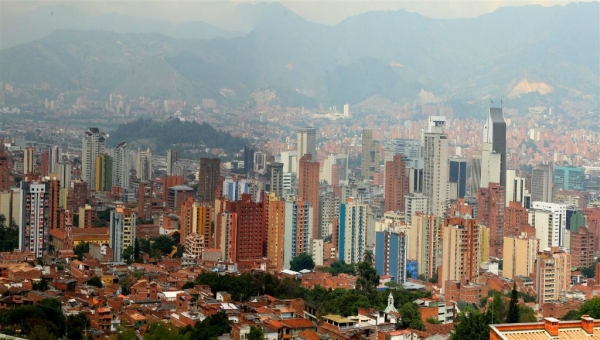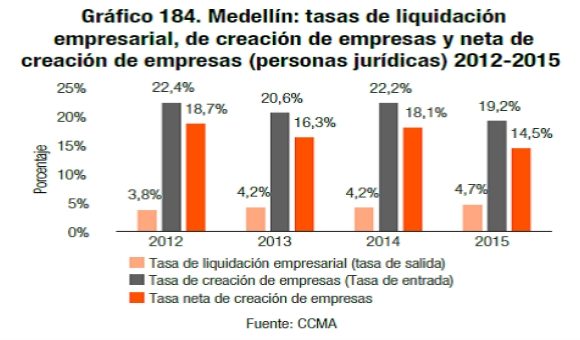Medellin’s Annual ‘Como Vamos’ Surveys, Studies Show Progress, Shortfalls

The latest annual “Medellin Como Vamos” (“How Are We Doing?”) survey (released October 2) of a representative sample of 1,520 local adults from all economic sectors shows that Medellin’s citizens are mostly satisfied with progress being made in many crucial areas — although recent security problems need more attention.
While Medellin has seen a huge and continuing reduction in homicide rates and other types of violence in recent years, personal robberies and thefts have been on the rise recently, with cell-phone thefts especially notable.
For example, Medellin’s Secretary of Security — Sergio Vargas Colmenares — revealed this month that certain types of thefts rose 48% year-on-year, affecting a total of 5,575 persons, up from 3,763 persons in 2014, as noted in a report from local newspaper, El Colombiano.
The older downtown sector of Medellin recorded the highest rates of such personal robberies, followed by the Laureles neighborhood. The posh El Poblado neighborhood came in third.
However, car thefts fell 28% year-on-year, to 1,185 cases, while motorcycle thefts fell 5.2% year-on-year, to 4,668 cases, according to a related “Medellin Como Vamos” study for full-year 2014.
But on the other hand, robberies on public streets and highways in 2014 rose 30.7% year-on-year, to 7,719 cases, the study found.
The “Como Vamos” survey found that 65% of such crimes involved personal (face-to-face) robberies, whereas only 5% of such crimes were thefts at residences. Another 5% involved car thefts.
As a result of the recent rise in robbery rates, 18% of Medellin’s citizens in the survey now say that they feel “insecure,” up from 13% four years ago. In total, 45% of citizens said they feel “very secure” while 36% said that they feel neither “insecure” nor “secure,” the survey found.
Despite these security issues, Medellin citizens are generally positive about the over-all direction of the city, the latest “Como Vamos” survey shows. In total, 81% of citizens feel that the city is headed in the right direction in trying to improve the lives of its residents.
Asked to rate the top-three items where the city ought to concentrate more of its efforts, 54% of citizens said “employment” ought to be the top priority, followed by health-care and then housing. Prioritization of “employment” was down sharply from 2013, when 80% said that should be the city’s prime focus.
Fully half of Medellin’s citizens said that their economic situation has improved in the last year, up from 45% in the prior-year survey.
Asked what are the most important factors that define “quality of life,” 77% of those surveyed said “health,” up from 73% in 2014. “Employment” was ranked second, at 57% (down from 60%) in 2014). Education, housing, family, urban habitat and security were the next-five factors, in that order.
In total, 89% of parents with children in Medellin’s private schools said they were “satisfied” with primary and secondary eduction, while 79% of parents with children in public schools said they were “satisfied.”
As for those using the national health care system (rather than those using the much-more-expensive prepaid health-insurance networks), the average wait-time between a request for certain services and actual service delivery was 11 days, the latest survey found.
Given the recent surge in demand for extensive health services (the result of recent law changes), only 52% of those surveyed in 2015 said they were “satisfied” with the health-care system today, down from 58% four years ago.
‘Quality of Life’ Study
Meanwhile, the most recent annual “Medellin Como Vamos” statistical study — released prior to the latest annual citizen survey — shows how the city has improved in many key areas over the last 10 years.
The report analyzes changes in Medellin’s demographics, poverty rates, education, health, employment, public safety, housing, utilities, environment, transport mobility, public space, municipal finance, civic responsibility, entrepreneurship and economic competitiveness.
The rate of population growth fell to less-than 1% year-on-year in 2014, compared to 1.02% in 2013, the study shows. As a result, Medellin’s population grew by 23,798 last year, to 2.44 million (although the metro area population is more than 3.5 million), the report shows.
The main sources of statistics for the latest “Medellin Como Vamos” report are the city’s Division of Information in the Department of Planning, city utility EPM (Empresas Publicas de Medellin), the Municipal Comptroller, the Colombian Chamber of Construction (Camacol), the Department of Social Welfare, the Chamber of Commerce of Medellin, the National Administrative Department of Statistics (DANE), the Department of National Planning, the Colombian Institute of Development of Higher Education, the Ministry of Health and Social Protectio, the Ministry of Education and the World Bank, according to the report.
The report found that Medellin led all cities in Colombia in terms of public investment per-capita, thanks in part to the recent sale of the former city-owned “Une” telecom company to Millicom. This boosted the city’s per-capita public spending on citizens to COP$1.95 million (US$646), up COP$410,000 (US$136) over the prior year, the report found.
Medellin also has seen reductions in its unemployment rate (to 10.2%) and a dip in its rate of “informal” employment, the report found. Those citizens with more formal education earned more than those with relatively little formal education, according to the report.
Poverty rates also have declined, thanks to many programs offered by national and city governments. However, a “worrisome” trend is that “a significant percentage of beneficiaries remain several years in the program[s] without achieving the goals that lift them out their condition,” the report added.
Despite efforts to build many more public schools and expand educational opportunities, Medellin still suffers from having too many students drop-out of school as well as having too many students that must repeat school years, the study found.
Transport Mobility
The report notes that Medellin is spending much more funds on improving urban transport, especially on roads and bridges.
However, “until now, investment has been minimal for more sustainable modes of mobility, such as pedestrian and bicycle” modes, according to the report.
On the other hand, the city’s latest transport management plan “reverses the pyramid prioritized for private vehicles, leaving [cars] as last option, while the pedestrian and cyclist modes take first place, with ambitious goals in terms of kilometers of track for both modes of [bike and pedestrian] transport, between now and 2028,” the report notes.
While 15.7% of Medellin’s total city budget in 2014 went for transport improvements, the personal-vehicle parc growth has outrun infrastructure growth, the report notes. Skyrocketing rates of motorcycle purchases resulted in motorcycles outnumbering cars since 2012, the report adds.
As for public transport, the new trolley-train in the Ayacucho neighborhood as well as two more overhead gondola (“Metrocable”) systems are nearly complete, the report adds. Medellin is already far ahead of the rest of Colombia in building and operating zero-emissions, all-electric Metro-rail and Metrocable systems, with more than 1 million citizens using public transport daily.
Commerce, Employment
Medellin created about 65,000 new jobs between 2013 and 2014 – a 3.8% growth rate, and an improvement over the 2012-2013 period, according to the report.
The sectors with the largest number of jobs created in the last two years were “transport, warehousing and communications” (31,429 new jobs) followed by real-estate activities (9,227 new jobs) and manufacturing (8,338 new jobs), the study shows.
“Commerce, hotels and restaurants” produced 5,107 new jobs, while mining produced 782 new jobs, the study shows.
Financial services saw a contraction of 1,503 jobs, while agriculture, cattle-ranching and fishing sectors saw a net decline of 4,578 jobs. Construction saw a net decline of 9,956 jobs, while community-service jobs shrunk by 20,418, according to the report.
The “commerce, restaurant and hotel” sector had the greatest proportion of “informal” jobs, at 41.7% of all the jobs in Medellin. Community-service and real-estate jobs accounted for another 16.1% of all the jobs in Medellin. In contrast, industrial jobs represented one of the lowest rates of “informal” employment, at 13.2%, according to the study.
Education
In 2014, the city invested a record COP$1.2 billion (US$398 million) in public-school education, thanks in part to the extra revenues received from the sale of the “Une” telecom company to Millicom, the study shows.
However, standardized student-knowledge tests administered to fifth-grade and ninth-grade students showed only small improvements over the past four years, the study shows. For example: “insufficient” and “minimal” knowledge rates as recorded for mathematics fell to 72%, down from 75% four years earlier, the study shows.
Health Care
Between 2008 and 2014, Medellín invested on average 14.1% of its total city budget on public health, the study shows.
In per-capita terms, the average city investment was COP$200,000 (US$66) per year, mainly for the “subsidized” sector of the population — a sector that doesn’t contribute anything to the national health care system, and which gets much of its funding from the national government. Medellin’s “subsidized” spending in health care rose 17% from 2011 to 2012, the report notes.
Housing
In 2014, the total number of housing units in Medellin rose to 775,283, of which 76% were in the “one, two and three” economic strata classes, with the “one” and “two” strata representing the poorest populations.
According to the study, Medellin has a deficit of 23,470 housing units, almost exclusively among the poorest populations. The city has invested an average of 2.9% of its public funds on public housing each year from 2008 to 2014, although that figure jumped to 4.9% in 2013, the study found.
In terms of housing-quality deficits, the lack of connections to public water and sewer systems in 2014 was found in 27,581 housing units, up 2% year-on-year — despite a big increase in public spending on public water system infrastructure, the study found.
Demand for housing in Medellin jumped drastically in 2014, to 39,772 housing units, up from 16,097 in 2013, the study shows. While the Bank of the Republic has raised interest rates in recent years, this hasn’t affected mortgage interest rates – at least, so far, according to the study.
In addition, the national government’s “PIPE” economic stimulus program subsidizes mortgage interest rates for home purchases at values from COP$80 million (US$26,500) to COP$197 million (US$65,300), the report noted.
A parallel “VIP” program that subsidizes lower-income housing also has stimulated housing demand in Medellin, according to the report.
Public Utilities
Medellin’s citizens continue to improve in terms of the rate of prompt bill-payment for the city’s relatively reliable, well-financed public utilities including water, electricity, natural gas and sewerage, the study shows.
As reported by public utility EPM, the rate of non-payment or past-due payment for public utility services continues to fall. For electric power, only 11,182 households were past-due paying their bills in 2014, versus 29,486 in 2008 – down 62% in the study period.
As for drinking-water past-due bills, this fell to 20,874 households in 2014 versus 38,574 in 2008. As for natural gas past-due bills, this fell to 13,351 households in 2014, versus 16,570 in 2010, the study shows.
EPM’s novel pre-pay system for electric power in poorer neighborhoods has helped avoid past-due payment problems, the study shows. Customers can buy pre-pay cards conveniently at local neighborhood markets — and the system encourages rational use of electricity. As a result, EPM has sucessfully installed tens of thousands of pre-pay meters at customer premises.
Environmental Conditions
While Medellin’s citizens have seen many improvements in quality-of-life, air quality unfortunately has deteriorated because of the explosive growth in motorcycle, car and truck populations in recent years.
As a result, ambient levels of fine particulates (PM10 and PM2.5) have risen, the study shows.
As for water quality, a huge sewage-treatment plant project for metro Medellin — sited in the neighboring municipality of Bello — is nearly complete, which eventually will result in a drastic improvement in water quality in Rio Medellin, the main river that runs through the city and its suburbs. But meanwhile, the quality of water in Rio Medellin has deteriorated, the study shows.
As for garbage collection and disposal, recycling rates improved to 14.5% in 2014 versus 13.5% in 2013, the study shows.
As for noise pollution, the World Health Organization recommends that ambient noise in cities shouldn’t rise above 65 decibels during the day and 55 decibels at night, the study notes. However, Medellin has suffered noise pollution levels of 72 decibels during the day and 68.5 decibels at night, according to the study.
Public Parks
Medellin’s signal projects to improve “green” spaces and public parks include the “Jardin Circunvular” (parks that ring the city above the hillside neighborhoods) as well as the first phase of the under-construction “Parques del Rio” project, which will put some of the traffic volume underground along the main north-south highway, which runs parallel to Rio Medellin. This will create more “green” space alongside Rio Medellin.
Other projects including reforestation of the “Pan de Azucar” hill, ecological vegetable-garden projects (including a massive transformation of a former garbage dump in the Moravia neighborhood) and the creation of more neighborhood parks.
Public Finance
Medellin’s public debt situation continues to improve, thanks in part to the recent sale of the Une telecom company.
Compared to Colombia’s other major cities, Medellin during the 2008-2014 period has been making the biggest per-capita public investments, the study found.
According to national statistics, Medellin since 2008 has demonstrated that its public finances have been “solvent,” with the exception of 2009, when the city temporarily dipped below a key finance indicator, according to the report. However, by 2012, Medellin improved its score, second only to Bogota for highest rating on public finances.
City-owned public utlity EPM – which has evolved into an exceptionally profitable, multinational corporation — also represents an important source of city finance, at 21% of total city income, the report notes.
Economic Growth, Competitiveness
In 2014, gross domestic product (“PIB”) in Antioquia — of which Medellin is the departmental capital — grew at a rate of 4.5%, the report notes.
There are now 31 companies for each 1,000 inhabitants in Antioquia, up from 29 companies per 1,000 inhabitants in the prior-year study, according to the report. Most of these (86.5%) are “micro-enterprises,” according to the study.
On the other hand, the last four years produced a decline in the proportion of “micro-enterprises” and a simultaneous increase in small-and-medium enterprises — although this trend began to level-off in 2014, according to the study.
As for Medellin’s “competitiveness,” this is improving simultaneously with the evolution of better industrial organization, productivity, transport infrastructure, technology, human development, attraction of foreign investment and other factors, the study notes.
For example, foreign investors plowed US$572.6 million into Medellin between 2012 and 2014 in new and expanded business ventures, the report points out.
What’s more, the city of Medellin organized 46 events last year designed to help entrepreneurs improve in areas of management and innovation. The city also consolidated its “seed funding” program for technology companies, through its “Ruta N” technology center, the report notes.
Growth of new companies in Medellin has averaged 20% in the last three years, while liquidation of existing businesses has averaged 5% over the same period, according to the study. However, many of the new companies have relatively low capitalization, a trend that accelerated in 2014 versus 2013, the study shows.
















